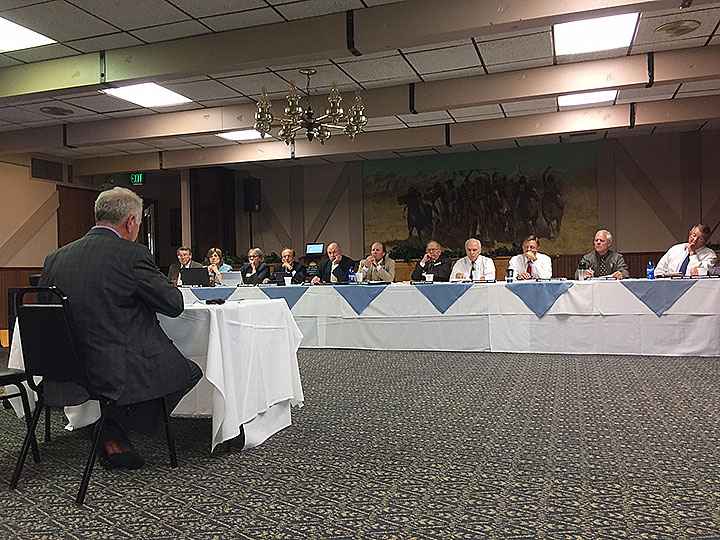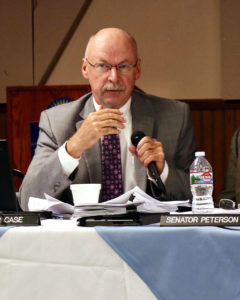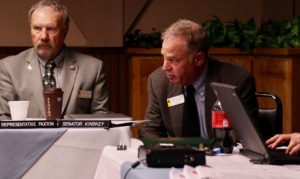
As the state searches for new funding sources, the Wyoming Legislature’s Joint Revenue Subcommittee met today in Thermopolis. Their work included a number of potential changes to the state’s tax code which may impact the work of physicians.
The state’s budget has struggled with the drop in severance tax income has led to a state deficit. The state did get some good news last week as the state’s consensus revenue estimating group (CREG) report, which forecasts the amount of money state government will have to spend into the future. Buck McVeigh of the Wyoming Taxpayers Association used to develop the CREG and now dissects it for the WTA. He states Revenue collections directed to the General Fund, Budget Reserve Account (BRA) and School Foundation Program (SFP) will exceed January 2017 CREG projections. Additionally, the Wyoming State Treasurer generated sizeable realized capital gains (which were not forecasted but were anticipated) from the Permanent Wyoming Mineral Trust Fund (PWMTF) and the Common School Permanent Land Fund (CSPLF). In summary, revenue collections to the General Fund and BRA are $91.5 million, or 7.8 percent ahead of the forecast pace of the January 2017 CREG estimates through June 2017 ($220.8 million, or 18.9 percent when including capital gains and losses).
In the interim, the state legislature is searching for ways to raise more money to address the state’s relatively empty coffers. The Joint Revenue Subcommittee has been asked to look at a number of ways to raise state revenue (taxes) including some that may impact physicians.
Two bills have been drafted by the Legislative Service Office which would add sales tax to a list of services not currently taxing its clients. While medical care specifically was not a part of the list of services which may be asked to tax clients, several services used by Wyoming physicians were. Included in the list of services which will potentially be taxed are legal services, lab testing, accounting services, facilities support, use of real estate agents, data processing and more.
The second bill specifically exempts health and social assistance services provided under NAICS code 62. However, there is no exemption for some of the services mentioned above such as accounting services.
“We don’t tax much of the medical care in the US, including prosthetics and other items that are sold with a prescription,” said Dan Noble, the state’s Revenue Department Director during testimony.
As expected, the draft bills brought a parade of lobbyists who testified against expansion of taxation on services. Among the arguments were the setup of such a system, and whether these taxes would lead to more out-of-state businesses poaching business in the Cowboy State.
There are other potential tax increases discussed that could have an impact on Wyoming physicians in and out of the office. A bill drafted and considered by the committee would increase property taxes by 2 percent on real and personal property.
The committee also asked the Legislative Services Office to draft an increase in sales tax statewide. This bill would increase sales tax by .5 percent for four years, with the resulting cash, which used to pay for major maintenance and construction of schools in the state. The State Construction Management Department suggests a two-year cost of $118 million to address the current condition of the state’s schools. It is estimated that this tax would bring in $140 million over the next two years if it were to pass the legislature as a whole in February.
The Joint Revenue Committee also considered the concept of gross receipts taxes. Nicole Keading, an economist for the Tax Foundation, was in Thermopolis to explain the tax  and used the example of a gallon of milk to explain the tax. In a gross receipts tax setting, the company who buys milk from the farm would be taxed, as would the company doing the packaging, the food distributor, the grocery, and the consumer. While this method does bring in a stable source of revenue, it is burdensome on retailing, wholesaling, and manufacturing sectors. It also seems very complicated and unpopular among states as just six states have a gross receipts tax in-place.
and used the example of a gallon of milk to explain the tax. In a gross receipts tax setting, the company who buys milk from the farm would be taxed, as would the company doing the packaging, the food distributor, the grocery, and the consumer. While this method does bring in a stable source of revenue, it is burdensome on retailing, wholesaling, and manufacturing sectors. It also seems very complicated and unpopular among states as just six states have a gross receipts tax in-place.
Alcohol and tobacco taxes were also discussed in Thermopolis with draft bills being requested for increased tax on beer and liquor, however tobacco tax changes were tabled for the time being.
Currently tax on beer is two cents per gallon, or one-third of a penny per can. This is far below the national rate of 20 cents per gallon. Sen. Ray Peterson (R-Cowley) requested the LSO draft a bill to bring the beer tax from two cents to 18 cents per gallon. Meanwhile, Sen. Dave Kinskey (R-Sheridan) proposal asked the LSO to draft a bill to raise the liquor tax and included a request to earmark a penny per bottle of liquor sold towards alcohol and drug prevention efforts which suffered serious funding cuts during the 2017 legislative session.
Cigarette and Tobacco Tax increases were hotly debated during the 2017 session only to be defeated in somewhat surprising fashion. The current cigarette tax hasn’t changed since 2003 when it moved from 12 cents per pack to 63 cents per pack. The Wyoming Department of Revenue suggested an increase of 10 cents per pack would increase the funding to state coffers by $2.8 million, while a 50 cent per pack increase would add $14.37 million to the state’s general fund and bring Wyoming in line with other regional states for the tax it levies on cigarette sales. The Revenue Subcommittee was also told a increase on wet snuff of 30 per ounce would result in another $4 million for the state.
However, a long standing controversy regarding cigarette sales on the Wind River Indian Reservation threw a monkey wrench into any plans to draft a law for higher cigarette taxes. A 1984 agreement, which originated from a Supreme Court case allows residents of the Wind River Reservation to buy non-stamped (non-taxed) cigarettes. Those not members of the reservation, may purchase cigarettes on the Reservation but are sold stamped and taxed cigarettes. Attempts to enforce this arrangement on the Reservation and collect tax revenues continues to be a sore spot for lawmakers. The concern among lawmakers was that unless the Wind River Reservation concerns were addressed added taxes to tobacco would simply cause more issues.
On Thursday, Wyoming Chief Deputy Attorney General John Knepper told the subcommittee his office is negotiating with cigarette manufacturers right now and may have news soon that will help address the issue before a state law is drafted. For that reason the subcommittee decided to table tobacco tax talks for the near term.
Before agreeing to table the discussion until after it received word from the Attorney General Office, a familiar cast of characters debated the merits of both sides of the tobacco tax issue. The American Cancer Society’s Cancer Action Network suggested the state doesn’t fund its prevention efforts to the levels recommended by the Centers for Disease

Control and tobacco-related costs to Wyoming Medicaid is higher than the amount of tobacco tax the state realizes. Meanwhile, lobbyists representing companies such as Phillip Morris suggested cigarettes are already taxed at a very high rate and estimating money raised by a tobacco tax increase was difficult to do because of changes in habit (people quit so the states don’t get as much money as it had hoped). Meanwhile a lobbyist from RJ Reynolds, Laurie Urbigkit, suggested her clients oppose such a tax hike because of what she termed a growing body of research suggesting moving smokers to non-incendiary tobacco (chew, e-cigarettes) is a safer alternative than smoking. Taxing tobacco which is not lit on fire at a higher rate would make the move to such product less attractive.
These bills still have a ways to go before becoming law. According to Joint Revenue Subcommittee Co-Chair Rep. Mike Madden (R-Johnson County), the next steps in determining the future of these tax bills will come Nov. 6-7 at the Committee’s meeting. The plan is for the Revenue Committee to rank the order of potential tax increases the state could pursue, meet with the state’s school recalibration committee (which is considering the state’s deficit and education’s role in that deficit), then decide which bills it would like to bring to the full legislature session slated for Feb. of 2018 during its Dec. 4-5 meeting in Casper.
